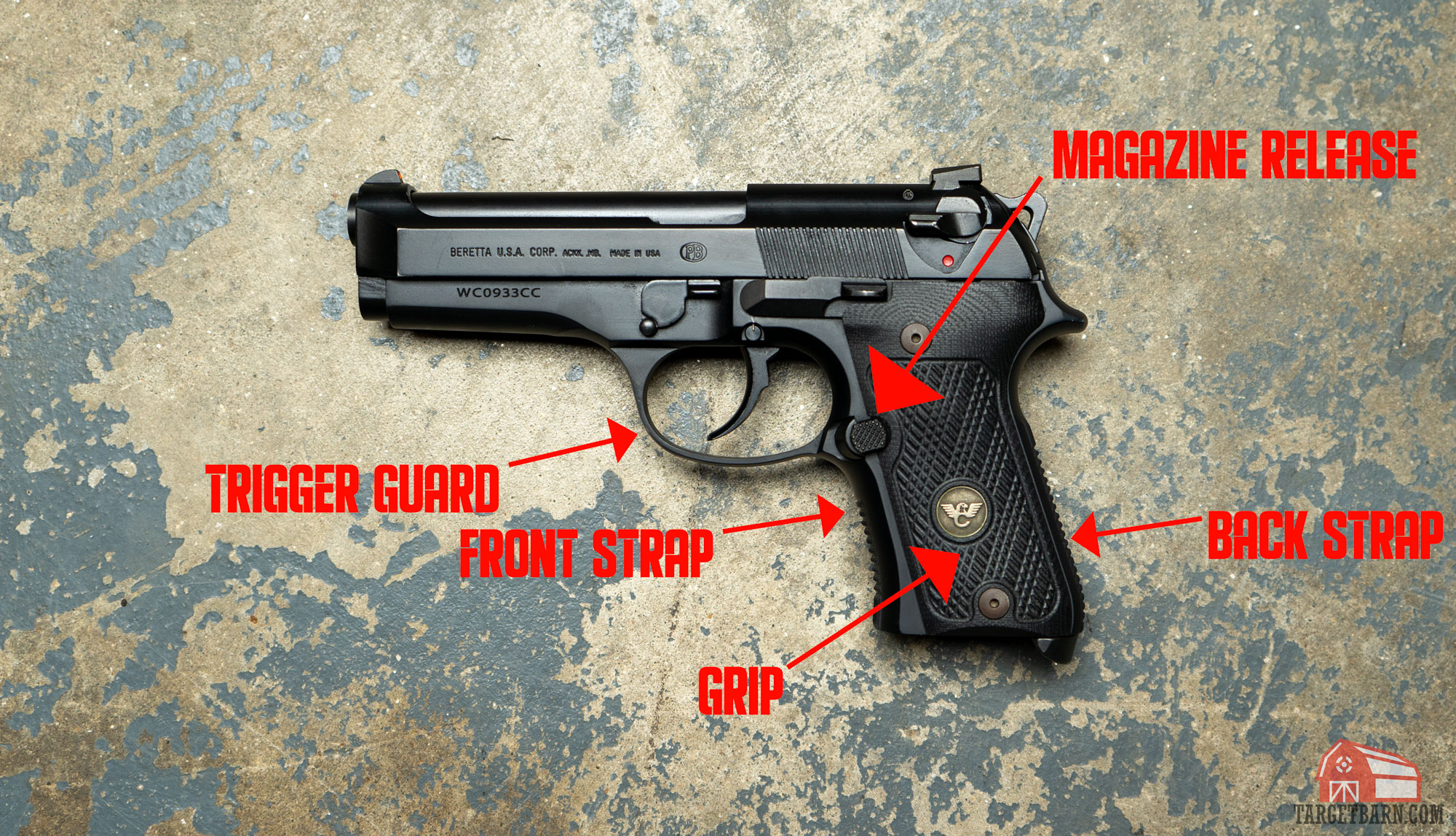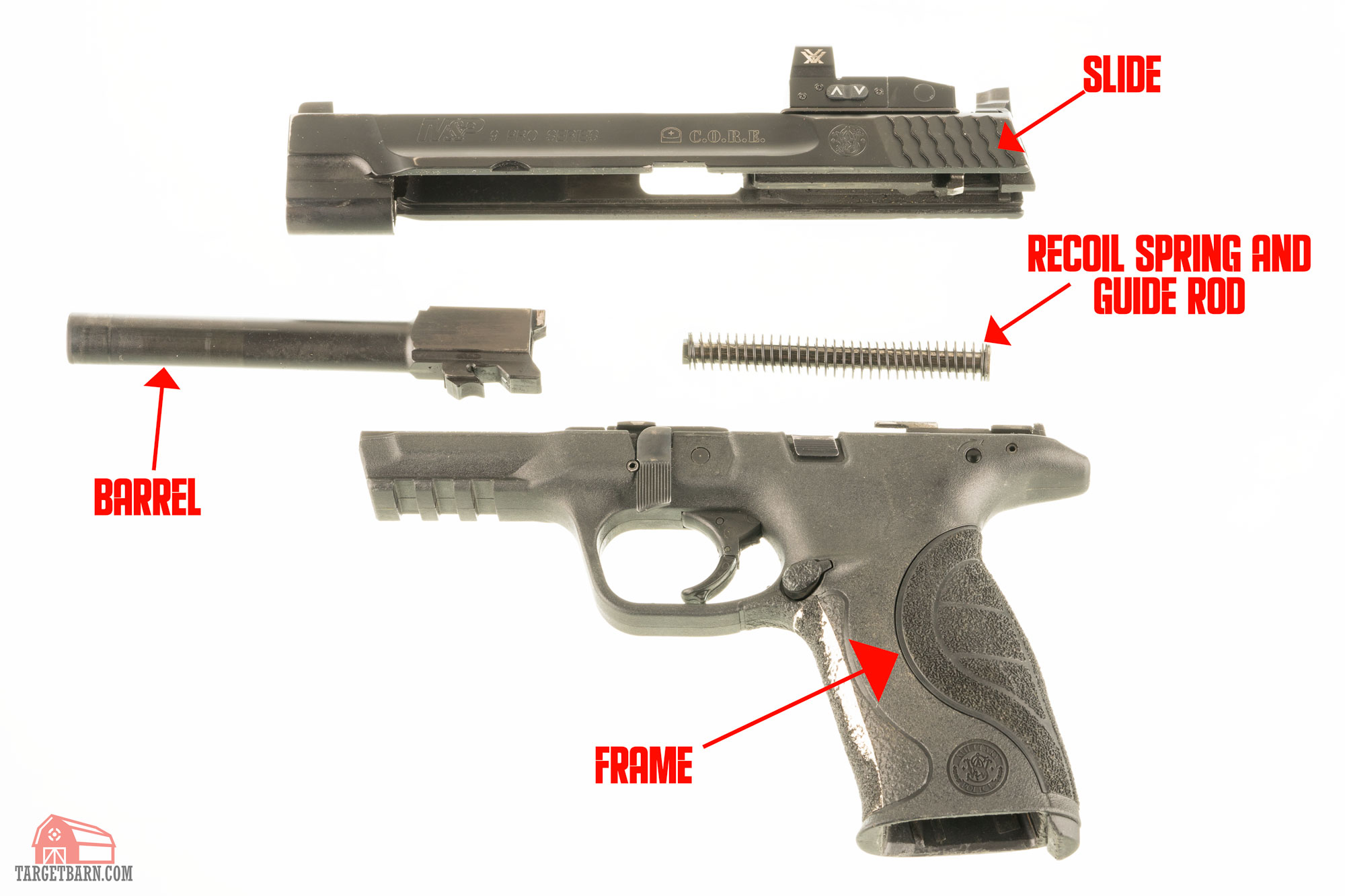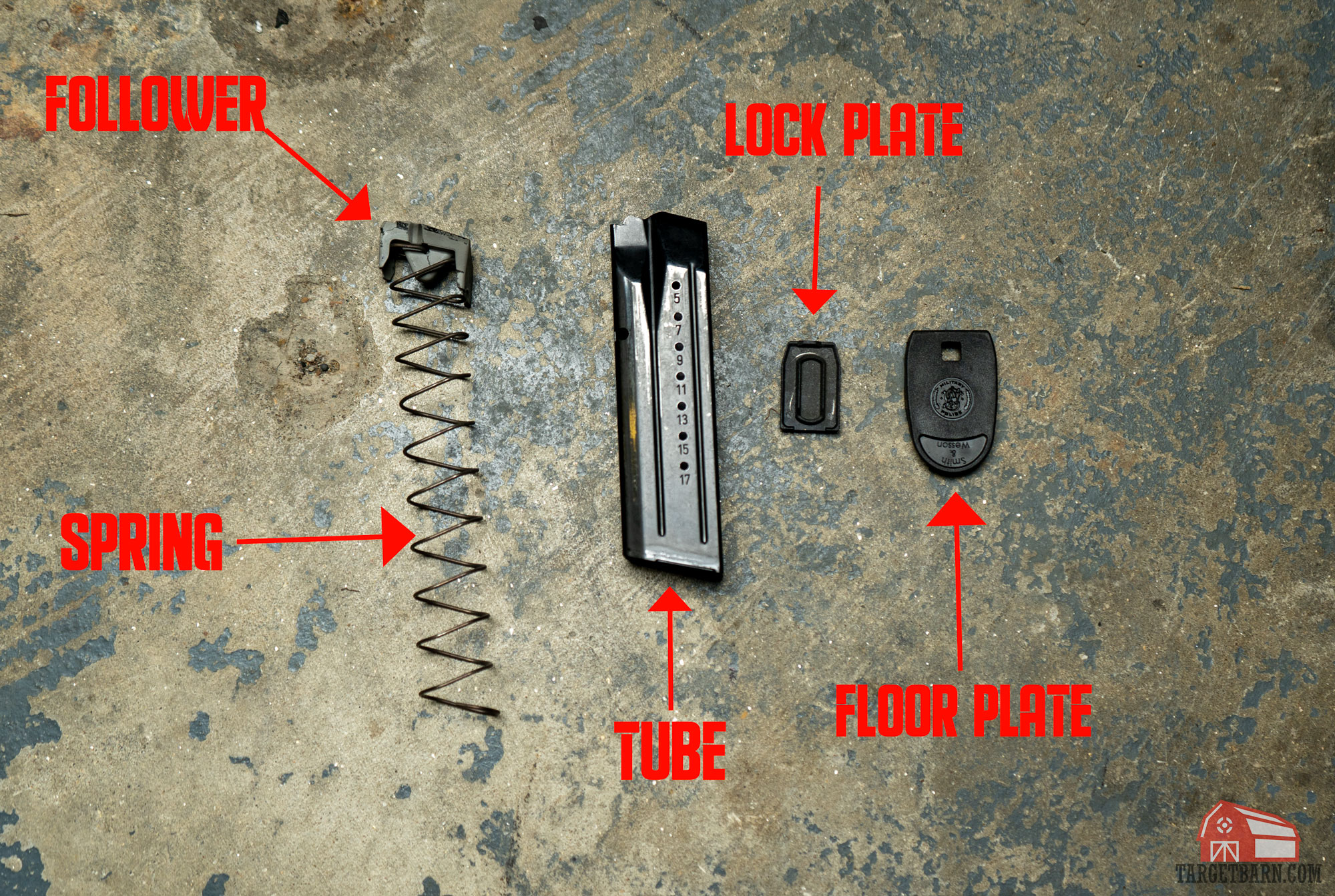If you are new to the wide world of handguns, you might not know all the parts of a pistol — yet. This guide doesn’t detail every single screw, spring and thingamabobber a handgun could possibly contain, but it will give you a fairly comprehensive overview of the major bits and bobs inside semi-automatic pistols.
Basic Parts of a Handgun
The parts of a pistol will depend on the type of pistol. For example, a revolver will have some different parts than a semi-auto handgun. Today we will cover the parts of a semi-auto pistol. We’ll cover the parts that make up a revolver in a future article.
The three basic parts of a pistol are the frame, barrel, and action. We’ll break down the parts of a pistol under these three broad categories.
Parts of a Pistol: Frame
The frame is the metal or polymer housing of the handgun which holds all its other parts. It is summed up as the body of the gun and is made up of the grip and trigger guard.
- Grip – The grip is the part of the pistol that the shooter holds. It has two sections: the front strap and back strap. In semi-auto handguns, it houses the magazine which is inserted through the bottom opening, known as the magazine well.
- Trigger Guard – A protective loop that surrounds the trigger to prevent the trigger from being accidentally pulled. It can be circular or rectangular.
- Magazine release – The button or other mechanism of a semi-auto pistol which allows the operator to remove the magazine. A “drop-free” magazine release will completely eject the magazine when engaged.
Parts of a Pistol: Barrel
The barrel is the tube the bullet passes through during ignition. The longer the barrel, the more time propellant gasses will have to exert their energy against the bullet to produce a faster muzzle velocity.
- Bore – The interior surface of a barrel.
- Rifling – Lands and groves which rotate the barrel to grant it gyroscopic stability and better accuracy.
- Muzzle – The front part of the barrel where the bullet exits the barrel.
- Chamber – The cavity at the back end of the barrel where the cartridge inserts prior to ignition. “Chambering a round” means you have made a cartridge ready to fire.
Parts of a Pistol: Action
The action of a pistol is a complex group of moving parts
- Trigger – The metal or polymer protrusion which forces the action to ignite the chambered cartridge when squeezed. Most handguns have trigger guards, which help to prevent accidental squeezing of the trigger.
- Trigger bar – A piece of metal which deactivates the handgun’s internal safety mechanism when the trigger is pulled. Without the trigger bar in place, the striker cannot travel through the firing pin channel to ignite the primer.
- Recoil spring – A spring which compresses as the slide moves backward to absorb some recoil energy before it can reach the shooter’s hands. Only a semi-auto pistol can have a recoil spring – not a revolver, which lacks a slide to compress a spring.
- Guide rod – Prevents the recoil spring from binding up under recoil.
- Firing pin – Also known as a striker, the firing pin is the part of the pistol which hits the cartridge’s primer once the shooter has sufficiently squeezed the trigger. The mechanical force of the firing pin crushes the explosive compound housed in the cartridge’s primer, which in turn ignites the propellant.
- Firing pin spring – Returns the firing pin to its ready state following ignition, and also averts an accidental discharge in the event the pistol is dropped or otherwise violently jarred.
- Extractor – The component which removes spent cases from the chamber in order to make way for new cartridges. The extractor automatically kicks into action in a semi-automatic pistol. A revolver’s extractor looks quite different, and is manually operated by depressing the extractor rod.
- Sear – The part of the trigger mechanism which holds the striker, bolt, or hammer back until the shooter has sufficiently squeezed the trigger.
- Hammer – The part of the handgun which strikes (or forces the firing pin to strike) the primer of the chambered cartridge. Depending on its design, you may need to cock a pistol’s hammer backward prior to firing the first shot (or every shot).
- Spring cup – Protects the firing pin channel, primarily by allowing water to flow around the firing pin when the handgun has recently become wet.
- Safety – Any mechanism which, when engaged, makes the handgun inoperable. Never treat a handgun like it is harmless once its safety is on! The safety is a supplement to responsible firearm handling; it should not be the only degree of security you depend on to prevent an unintentional discharge.
- De-cocker – Also known as a manual decocking lever, drops the hammer on a live cartridge without risk of firing the round.
- Locking block – Also known as a striking block, this part of a semi-auto’s lower receiver only serves to secure and stabilize movement of the slide and barrel.
The Slide
- Slide – The upper part of a pistol which reciprocates (aka moves backward) with recoil to permit semi-automatic fire. The slide is the semi-auto pistol’s bolt carrier group, and contains the firing pin, extractor and usually the barrel. It also holds the gun’s sights.
- Slide lock – A mechanism which enables the shooter to keep the slide locked backward.
- Slide cover plate – The simple protective piece which attaches to the back of the slide. Easy to replace if you wish to customize your pistol.
- Sights – The front and rear sights of a semi-auto pistol that are located at the top of its slide. These allow you to aim your firearm.
Parts of a Magazine
The magazine is the detachable part of a semi-auto pistol which holds unfired rounds of ammunition. The magazine – or mag – is the primary reason behind the semi-auto’s widespread popularity, as it permits a practically unlimited rate of fire and lightning-fast reloads. The mag itself has multiple parts, including:
- Follower – Guides unfired cartridges into the chamber.
- Spring – Pushes up on the follower so it can feed reliably.
- Floor plate – The base of the mag, which is sometimes detachable to facilitate cleaning.
- Tube – The shaft of the magazine; its “body,” so to speak, which is most commonly double stack or single stack.
Like we said earlier, this is not a comprehensive list of every part you could possibly find in a handgun, but it should give you a good overview of all the components that come together to produce the most beautiful sound in the world: bang.
















